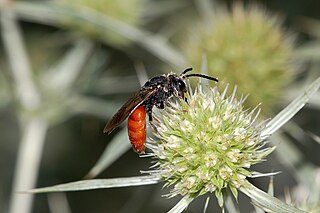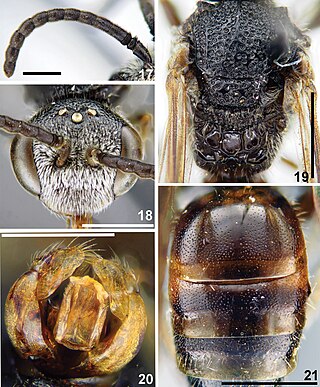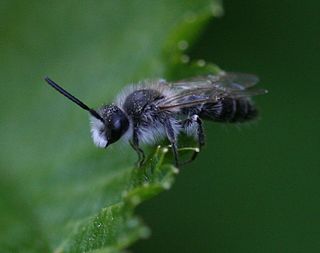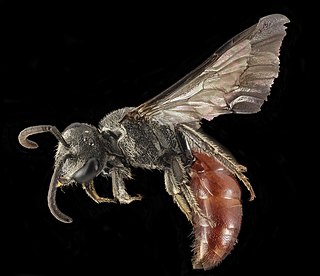
Psenes pellucidus, the bluefin driftfish, is a species of driftfish native to the Atlantic, Indian and Pacific oceans where it is found in deep waters to a depth of 1000 m. ). It is also present in low abundance since the mid-20th century in the western Mediterranean Sea which it most likely entered via the Strait of Gibraltar. It can reach a length of 80 cm TL.

Sphecodes albilabris is a solitary parasitic bee that is endemic to Central and Western Europe. It also occurs in North Africa and is thought to have been introduced to the United States and Australia by accident.
Heinrich Friedrich August Karl Ludwig Friese was a German biologist and entomologist, a specialist of bees (melittologist). Between 1883 and 1939, he described 1,989 new species and 564 new varieties or subspecies of insects, 99% of which were bees.
Phaxas pellucidus, the transparent razor shell, is a species of marine bivalve mollusc in the family Pharidae. It is found buried in the seabed in coastal waters of northwest Europe, often in great numbers.

Sphecodes biroi is a species of bee in the genus Sphecodes, of the family Halictidae.
Sphecodes crassicornis is a species of bee in the genus Sphecodes, of the family Halictidae.
Sphecodes decorus is a species of bee in the genus Sphecodes, of the family Halictidae. S. decorus has been documented in India and Sri Lanka.
The transparent blue-eye is a species of fish in the subfamily Pseudomugilinae. It is found in Irian Jaya in New Guinea.This species reaches a length of 3.1 cm (1.2 in).

Sphecodes is a genus of cuckoo bees from the family Halictidae, the majority of which are black and red in colour and are colloquially known as blood bees. Sphecodes bees are kleptoparasitic on other bees, especially bees in the genera Lasioglossum, Halictus and Andrena. The adults consume nectar, but because they use other bees' provisions to feed their offspring they do not collect pollen.

Sphecodes gibbus, the dark-winged blood bee, is a species of cleptoparasitic blood bee from the Palearctic. It is the type species of the genus Sphecodes and was first described by Carl Linnaeus as Sphex gibba in 1758.
Sphecodes mandibularis is a species of sweat bee in the family Halictidae.

Andrena barbilabris, the bearded miner bee, is a species of miner bee in the family Andrenidae. It is found in Europe and Northern Asia and North America.

Sphecodes ranunculi is a species of sweat bee in the family Halictidae.
Sphecodes heraclei is a species of sweat bee in the family Halictidae.
Sphecodes solonis is a species of sweat bee in the family Halictidae.
Sphecodes johnsonii is a species of sweat bee in the family Halictidae.

Sphecodes ferruginatus is a Palearctic species of sweat bee.








